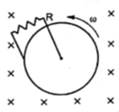Figure shows a conducting disc rotating about its resistance R is connected between the centre and the rim. Calculate the current in the resistor. Does it enter the disc or leave it at the centre? The radius of the disc is 5.0 cm, angular speed ω = 10 rad/s, B = 0.40 T and R = 10 Ω.

Given:
Resistance(R) = 10Ω
Radius(r) = 5 cm = 0.05 m
Angular speed(w) = 10 rad/s
Magnetic field(B) = 0.4 T
Formula used:
We consider a rod of length 5 cm from the centre and rotating with same w.
Hence, length of sliding rod(l) = 5 cm = 0.05 m.
Now, induced emf ![]() … (i), where B = magnetic field, l = length of sliding rod, v = velocity
… (i), where B = magnetic field, l = length of sliding rod, v = velocity
Now, velocity ![]() … (ii), where l = length or rod, w = angular velocity
… (ii), where l = length or rod, w = angular velocity
From Ohm’s law, current through resistor R(I) = E/R = Bl2w/2R (from (i) and (ii)), where E = emf, R = resistance
Hence, ![]() A = 0.5 mA (Ans)
A = 0.5 mA (Ans)
Since the disc is rotating anticlockwise, the emf induced is such that the centre is at a higher potential than the periphery. Hence, the current leaves from the centre.